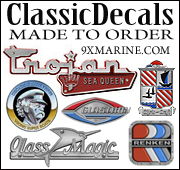Plywood
What is the difference between marine grade plywood and the plywood you buy at Home Depot? There are two differences. The first is the glue that binds the plies together. Marine plywood will use an exterior grade glue that is UV resistant. Regular exterior grade plywood uses the same glue.
The other difference is the number of voids in the plywood. Marine grade plywood should have no voids at all. A standard exterior grade plywood from a hardware store will have multiple voids throughout all the inner plies of the wood.
Think of these voids as the seeds from which delamination grows. As the boat flexes underway and the motor vibrates against the transom, any voids in the core will quickly spread to wide areas of delamination.
Because plywood alternates the grain direction between plies, it is inherently more stable than solid wood or end grain balsa. The best marine plywoods will also use plies made from wood that are highly stable such as Okoume and Meranti.
Plywood as a core material is the first in this list that is appropriate for transom repair. Plywood is less susceptible to rot than Balsa and has a much higher compressive strength. This means that you can hang your twin outboards on a plywood cored transom without worrying about whether the transom will deform around the fasteners.
Additionally, most classic fiberglass boats were build with plywood transoms. This means that replacement with the same product will not adversely affect the weight of the boat.
The down side to plywood is that while it's less susceptible to rot than the previously mentioned options, it isn't “rot-proof”. Plywood, mixed with water, and encapsulated in fiberglass, will just as conclusively, rot away to mush. It will just take a little bit longer.









